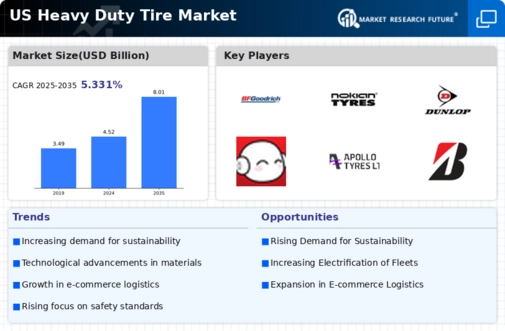Increasing Freight Transportation Demand
The heavy duty-tire market experiences a notable boost due to the rising demand for freight transportation across the United States. As e-commerce and retail sectors expand, the need for efficient logistics and supply chain solutions intensifies. In 2025, the freight transportation industry is projected to grow by approximately 4.5%, leading to an increased requirement for heavy duty tires. This growth is driven by the need for timely deliveries and the expansion of distribution networks. Consequently, manufacturers in the heavy duty-tire market are likely to focus on producing tires that can withstand the rigors of long-haul transportation, thereby enhancing durability and performance. The interplay between freight demand and tire innovation suggests a robust market environment, where companies must adapt to evolving transportation needs.
Rising Fuel Prices and Efficiency Demands
The heavy duty-tire market is also affected by fluctuations in fuel prices, which directly impact operational costs for transportation companies. As fuel prices rise, there is an increasing demand for tires that enhance fuel efficiency. Tires designed with lower rolling resistance can significantly reduce fuel consumption, making them attractive to fleet operators looking to minimize expenses. In 2025, it is anticipated that the average price of diesel fuel will increase by approximately 10%, prompting fleets to seek out high-performance tires that offer better mileage. This trend indicates a shift in purchasing behavior, where cost-effectiveness and efficiency become paramount. Consequently, manufacturers in the heavy duty-tire market must focus on developing products that not only meet performance standards but also contribute to overall cost savings for their customers.
Regulatory Compliance and Safety Standards
The heavy duty-tire market is significantly influenced by stringent regulatory compliance and safety standards imposed by government agencies. In the US, regulations regarding tire performance, safety, and environmental impact are becoming increasingly rigorous. For instance, the National Highway Traffic Safety Administration (NHTSA) mandates specific performance criteria for tires used in commercial vehicles. As a result, manufacturers are compelled to invest in research and development to meet these standards, which may lead to innovations in tire technology. The emphasis on safety not only enhances consumer confidence but also drives market growth, as fleets prioritize compliance to avoid penalties. This regulatory landscape creates opportunities for companies in the heavy duty-tire market to differentiate themselves through superior safety features and performance metrics.
Growth of the Construction and Mining Sectors
The heavy duty-tire market is positioned for growth due to the expansion of the construction and mining sectors in the United States. As infrastructure projects gain momentum, the demand for heavy machinery and vehicles increases, subsequently driving the need for specialized tires. In 2025, the construction industry is projected to grow by 6%, which will likely lead to a corresponding rise in the demand for heavy duty tires designed for off-road applications. These tires must withstand harsh conditions and provide optimal traction and durability. Additionally, the mining sector's recovery and expansion further contribute to this demand, as heavy equipment requires reliable tires to operate efficiently. This synergy between industry growth and tire demand presents a favorable outlook for the heavy duty-tire market.
Technological Innovations in Tire Manufacturing
Technological advancements in tire manufacturing are reshaping the heavy duty-tire market. Innovations such as advanced materials, smart tire technology, and improved manufacturing processes are enhancing tire performance and longevity. For example, the integration of sensors in tires allows for real-time monitoring of tire pressure and temperature, which can prevent blowouts and improve fuel efficiency. The heavy duty-tire market is expected to grow at a rate of around 5% annually as these technologies become more prevalent. Additionally, the adoption of sustainable materials in tire production aligns with industry trends towards environmental responsibility. As manufacturers embrace these innovations, they are likely to gain a competitive edge, appealing to fleets that prioritize efficiency and sustainability.

















Leave a Comment